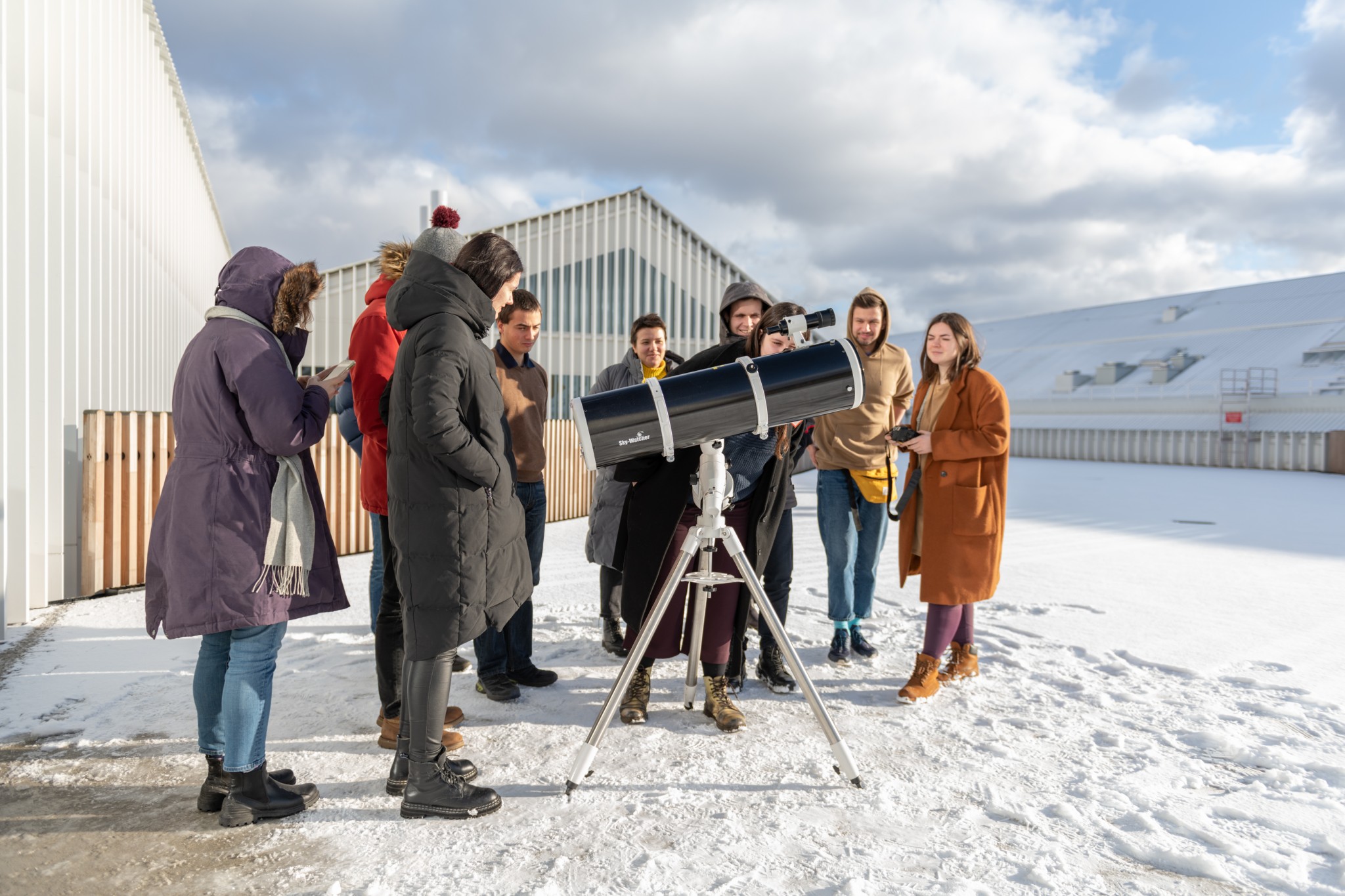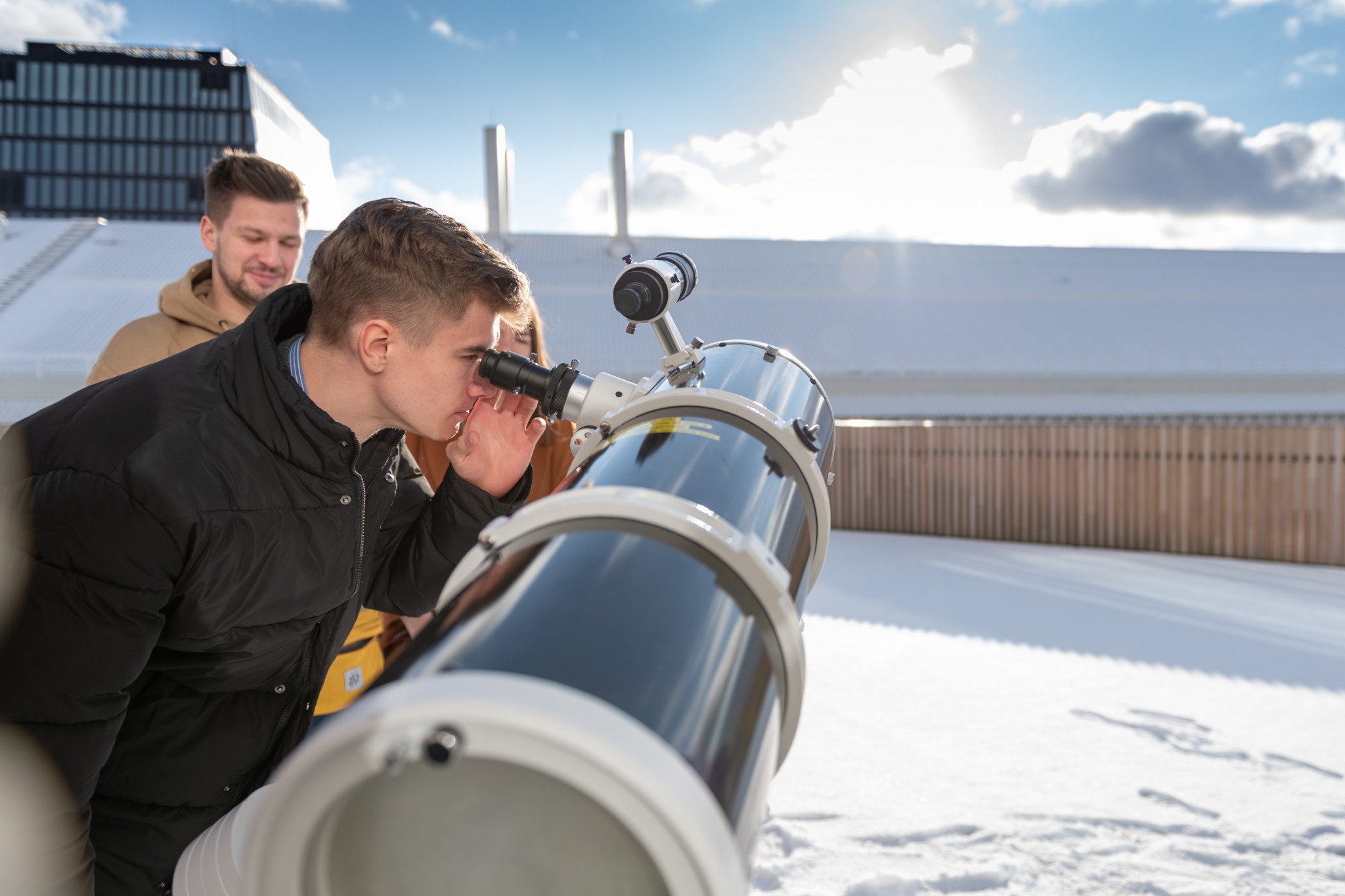Assistant Professor Tatiana Podladchikova of the Skoltech Space Center (SSC), Nikita Veliev, an engineer of the SSC, and Galina Chikunova, a PhD student of the SSC, recently created a course for the Independent Studies Period (ISP) titled “Solar Observations with a Telescope.”
What gave them the idea to run it? After Arkady Dvorkovic, Chairman of the Skoltech Board of Trustees, donated a high-end Sky-Watcher telescope to the SSC, Nikita decided to create the course.
“When it was gifted to our center, I was responsible for assembling it and setting everything up. I then began thinking that if the students want to use it, we should instruct them,” said Nikita.
Realizing that it made more sense to teach students in groups rather than on an individual basis, he created an ISP course. As well as teaching basic astronomy, the main goal of the program is to teach students how, when and where they can use a telescope, with a special focus on solar observation.
While the telescope in question is of the more advanced kind designed for experienced users, the fundamentals for use are very similar across the board. It has a maximum magnification of 400x, meaning that one could make out the colorful atmosphere of Venus (incidentally, the planet is very bright during the evenings at this time of year); likewise, Andromeda, the galaxy nearest the Milky Way (2.5 million light-years away), would be visible on a clear night without light pollution as an unmistakable galactic disk.
“This telescope is right in the middle of the scale between beginners and professional telescopes. You can see all the galaxies closest to the Milky Way, and, of course, you can observe the planets and stars,” said Nikita.
If you observe Andromeda, it might be a little overwhelming understanding that one is seeing an actual galaxy in its entirety; however, when the observer also realizes that they are staring 2.5 million years into the past – the time it takes for the galaxy’s light to reach Earth – it adds yet another sense of the immensity of our Universe.
The course began with an introduction to astronomy; the students learn celestial coordinates, and why there are different mounts for the telescope as well as different instruments for tracking planets, the stars, and the Sun.
“Apart from the introduction to astronomy and solar physics, we also have practical lessons and labs for data processing. The goal is to gather data using the telescope, if the weather conditions allow it, and then to process the aforementioned data,” said Galina Chikunova, a PhD student of the SSC.
The course focuses on solar observation, but also includes night sky observation. One might ask, how does one look at the Sun with a telescope? Of course, it is a sure way to blind yourself if you don’t have the appropriate filters; but with the right equipment, you can look directly at it and witness phenomena such as sunspots.
On Thursday, January 23, the sky cleared for the first time in what felt like weeks, and the class got to try out the telescope.
“A lot of people are disconnected from what it means to calculate time, why the seasons change, and how the Earth rotates. We take these for granted, because we have our navigation coordinates in our smartphones. Before the technology of our era, people paid attention to the methods for tracking time such as which calendar they should use. Nowadays, we don’t think about that. For example, why celebrate Christmas on January 7 instead of December 25? Why does the Sun rise at different times every day? Why is it higher in the summer than during the winter? Many people don’t think about these things,” said Galina.
The 12 students taking part are all from different backgrounds and Nikita and Galina made no bones about the course being open to anyone who wants to learn about astronomy, the use of telescopes, and the Sun.
“We are doing this course to teach people from all different fields. To us, there is no such thing as a stupid question, the goal is to learn!” said Nikita.
“The telescope is one of civilization’s greatest instruments. With its invention in the early 17th century, Galileo Galilei and other European astronomers discovered sunspots – dark areas on the surface of the Sun. In the 21st century, people are already sending man-made spacecraft to the Sun. Right now, we are preparing for an unprecedented amount of new data from two of the first ever missions to ‘touch’ the Sun; these are expected to revolutionize our understanding of our nearest star and the heliosphere surrounding us. The two missions are NASA’s Parker Solar Probe (launched in August 2018) and ESA’s Solar Orbiter (expected launch in February 2020). With this course, we want to provide a hands-on experience on observing the Sun and stars, which we hope will become a basis and inspiration for future breakthroughs.” – Assistant Professor Tatiana Podladchikova (SSC)
About the Independent Studies Period
The Independent Studies Period (ISP) is an annual program targeted at MSc students that has taken place every January since 2014. The four focus areas for students are to develop different skills and knowledge: Broadening Horizons – Beyond Profession, Soft Skills Development, Entrepreneurship and Innovation (E&I), Career Development.
Master’s students will have the chance to explore avenues of learning that differ, though not necessarily, to their traditional science and engineering backgrounds. It is built around a core of external instructors as well as Skoltech faculty and members of the student body (both MSc and PhD), all teaching courses on topics such as public speaking, academic writing, science in contemporary art, an introduction to cybersecurity, a stock trading course, science and cooking, and so on.
By its very nature, the program is interdisciplinary and helps raise the next generation of science, technology and business leaders, and students get the chance to work on cool, innovative projects.
2020 marks the seventh ISP and this year there is a choice of 36 different courses.
Contact information:
Skoltech Communications
+7 (495) 280 14 81


